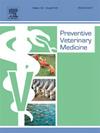Spatial and temporal risk assessment of Epizootic Hemorrhagic Disease Virus introduction in Europe: A comparative analysis of trade and wind dispersal pathways
IF 2.4
2区 农林科学
Q1 VETERINARY SCIENCES
引用次数: 0
Abstract
Epizootic Hemorrhagic Disease Virus (EHDV), transmitted by Culicoides biting midges, is a threat for the livestock sector in Europe. A quantitative risk assessment model framework was developed to assess the risk of EHDV introduction in Europe, through wind dispersal of Culicoides and trade in live animals. The model integrates meteorological data, wind trajectories, vector biology, livestock trade information and considers disease dynamic in infected sources as well as disease susceptibility in potential destinations. The full risk zone combining both pathways encompassed 42 different countries with 30 in Europe and 12 outside, each with highly-variable levels of risk. The highest risk countries included three sources: France, Spain, Italy, and one disease-free, Germany. The period of highest risk corresponded to the favourable period of Culicoides activity, between May and October. Risk estimates were markedly higher for the wind pathway, spanning 20 countries mainly in Western Europe, compared to the trade pathway that covered 40 countries, including distant Eastern ones, like Romania. The Pathway Risk Ratio (PRR) showed a higher wind pathway contribution in most countries where both pathways were present. France was the primary source country, regardless of the pathway. Alternative scenarios suggested that limiting the source area to 2024 infected areas or considering long trade history could reduce the list of at-risk countries. However, underreporting or reducing PCR testing at borders could increase risk estimates. This research aims to guide disease risk management measures by providing insights into the risk of Culicoides-borne disease extension.
流行性出血热病毒传入欧洲的时空风险评估:贸易和风传播途径的比较分析
由库蠓传播的动物流行性出血病病毒(EHDV)对欧洲畜牧业构成威胁。制定了定量风险评估模型框架,以评估通过库蠓的风传播和活体动物交易在欧洲传播EHDV的风险。该模型综合了气象数据、风轨迹、媒介生物学、牲畜贸易信息,并考虑了感染源的疾病动态以及潜在目的地的疾病易感性。结合这两种途径的完整风险区域包括42个不同的国家,其中30个在欧洲,12个在欧洲以外,每个国家的风险水平都是高度可变的。风险最高的国家包括三个来源:法国、西班牙、意大利和一个无疾病的国家——德国。5月至10月是库蠓活动的高峰期,危险性最高。与贸易路线覆盖40个国家(包括罗马尼亚等遥远的东方国家)相比,风电路线的风险估计明显更高,主要覆盖西欧的20个国家。途径风险比(PRR)显示,在大多数存在两种途径的国家,风途径的贡献更高。无论途径如何,法国都是主要的来源国。替代方案表明,将源头区域限制在2024年感染地区或考虑长期贸易历史可以减少风险国家的名单。然而,在边境少报或减少PCR检测可能会增加风险估计。本研究旨在通过深入了解库蠓传播疾病传播的风险,指导疾病风险管理措施。
本文章由计算机程序翻译,如有差异,请以英文原文为准。
求助全文
约1分钟内获得全文
求助全文
来源期刊

Preventive veterinary medicine
农林科学-兽医学
CiteScore
5.60
自引率
7.70%
发文量
184
审稿时长
3 months
期刊介绍:
Preventive Veterinary Medicine is one of the leading international resources for scientific reports on animal health programs and preventive veterinary medicine. The journal follows the guidelines for standardizing and strengthening the reporting of biomedical research which are available from the CONSORT, MOOSE, PRISMA, REFLECT, STARD, and STROBE statements. The journal focuses on:
Epidemiology of health events relevant to domestic and wild animals;
Economic impacts of epidemic and endemic animal and zoonotic diseases;
Latest methods and approaches in veterinary epidemiology;
Disease and infection control or eradication measures;
The "One Health" concept and the relationships between veterinary medicine, human health, animal-production systems, and the environment;
Development of new techniques in surveillance systems and diagnosis;
Evaluation and control of diseases in animal populations.
 求助内容:
求助内容: 应助结果提醒方式:
应助结果提醒方式:


